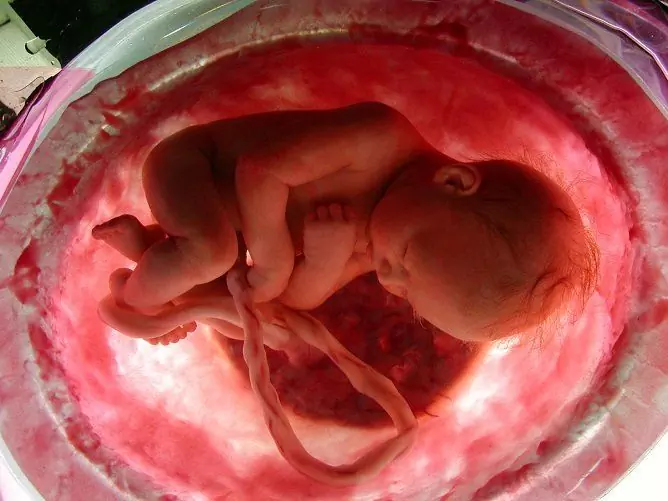- Author Rachel Wainwright [email protected].
- Public 2023-12-15 07:39.
- Last modified 2025-11-02 20:14.
Umbilical hernia during pregnancy
The content of the article:
- What it is
- Reasons for the formation of a hernia during pregnancy
-
How does the disease manifest
- With an uncomplicated course
- If there are complications
-
Diagnostic methods
- When to see a doctor
- Additional diagnostics
-
What to do if a hernia is detected
- Before giving birth
- After childbirth
- Preventive actions
- Why is pathology dangerous?
- Video
Pregnancy is a difficult period for the female body. The expectant mother often faces a number of unpleasant conditions - heartburn, varicose veins, hemorrhoids. Umbilical hernia during pregnancy is no exception. The disease does not pose a particular danger to the life of a woman and a baby. In most cases, the only sign of the disease is a protrusion in the navel, other symptoms appear only with a complicated course. Radical treatment of hernia for pregnant women is not performed, it is recommended to wear a bandage and exclude the influence of provoking factors.

Umbilical hernia often develops in pregnant women, but it is characteristic not only of them
What it is
An umbilical hernia is a protrusion of internal organs outside the abdominal cavity through the umbilical ring. Bowel loops, peritoneal sheets, adipose tissue can protrude.
The disease occurs not only in pregnant women, on average 5% of the entire adult population is sick. However, women during pregnancy are more susceptible to the onset of pathology, which is associated with a number of provoking factors. The chances of a hernia increase with repeated and multiple pregnancies, large fetuses.
Reasons for the formation of a hernia during pregnancy
The umbilical ring is one of the weakest spots on the belly. There is no layer of muscles and subcutaneous fat in the navel, which creates the prerequisites for the formation of a hernia.
The impact of provoking factors against the background of weakness of the abdominal wall leads to the onset of the disease. The provoking factors include those that increase intra-abdominal pressure:
- chronic cough;
- frequent constipation;
- lifting weights;
- obesity.
Pregnancy is one such factor. The enlargement of the uterus increases intra-abdominal pressure, which leads to the divergence of the muscles in the umbilical ring. The larger the uterus, the higher the intra-abdominal pressure.
How does the disease manifest
The clinical symptoms of the disease depend on the size of the protrusion, the contents of the hernia (intestines, omentum or other organs), the presence of concomitant pathology and complications.
With an uncomplicated course
The main and often the only sign of the disease in an uncomplicated course is the presence of a spherical formation in the navel. What characteristics does such education have:
- decreases in a horizontal position;
- increases in a standing position;
- is adjusted when pressed;
- increases with coughing, straining.
In the 3rd trimester, the hernial sac remains almost empty, when palpation of the formation, emptiness is felt.
Additional symptoms may appear, which depend on the contents of the protrusion. If the loops of the small intestine protrude, additional pain occurs in the navel, constipation, flatulence, and nausea. If the greater omentum protrudes, the pain is usually not intense and does not have a specific localization.
If there are complications
When the hernia is infringed, the clinical picture changes - there is an acute pain in the abdomen, stool and gas retention, vomiting. Symptoms often develop acutely, within a few hours.
Diagnostic methods
It is possible to suspect the presence of an umbilical hernia at home by its characteristic symptoms (a spherical protrusion in the navel). To observe and choose treatment tactics, you need to consult a doctor. Sometimes additional tests are required.
When to see a doctor
A doctor should be consulted if a protrusion in the navel is detected. This is not an indication for hospitalization or emergency treatment, but it is not worth delaying.
If, in addition to protrusion, there is intense abdominal pain, stool retention, vomiting - you need to immediately call an ambulance. Most likely, there was an infringement of the hernia.
Additional diagnostics
Diagnosis of an umbilical hernia is usually straightforward. The doctor will examine and palpate the formation, collect anamnesis and complaints.
Additional diagnostics are required only if there are complications. In this case, an ultrasound examination (ultrasound) is usually prescribed. Radiography (overview, contrast, herniography) in pregnant women is not used.
What to do if a hernia is detected
The only effective method to get rid of protrusion is surgery (hernioplasty). But during pregnancy, radical treatment of the disease is not carried out, since the operation can negatively affect the health of the child. Therefore, conservative treatment methods are used that are safe for the baby and mother.
Before giving birth
During pregnancy, it is undesirable to carry out surgery, therefore, a conservative approach to treatment is used.
What will help get rid of pathology:
- wearing a special high bandage;
- limiting heavy physical activity;
- treatment of diseases that manifest themselves as a cough;
- adherence to a diet high in fiber (prevention of constipation).
In most cases, compliance with these recommendations allows you to avoid dangerous complications of the disease. Further treatment tactics depend on whether the protrusion persists after childbirth.
If, during pregnancy, the hernia is strangled, an emergency operation is indicated. The amount and type of surgery depends on the gestational age.

Wearing a high brace will help prevent complications.
After childbirth
After childbirth, the protrusion may disappear on its own. This is facilitated by strengthening the abdominal muscles and wearing a bandage.
If the protrusion has not disappeared after childbirth, a planned operation is indicated. The operation can be open or laparoscopic, in either case, general anesthesia (anesthesia) is used.
At the first stage of the surgical intervention, hernia repair is performed - the hernial sac with its contents is excised. Further, plastic is carried out using local fabrics or synthetic material. The choice of technique depends on the size of the hernia orifice (suturing for a small size, a synthetic prosthesis for a large one).
Preventive actions
It is, of course, impossible to influence the weakness of the abdominal wall in the umbilical region. But you can exclude the influence of provoking factors, thereby reducing the likelihood of developing the disease. How to prevent the development of pathology:
- strengthen the abdominal muscles before pregnancy;
- with increased body weight - follow a low-calorie diet, move more;
- eat more fruits, vegetables and herbs (prevention of constipation);
- undergo regular medical examinations.
Why is pathology dangerous?
In most cases, the prognosis is favorable. Complications are relatively rare during pregnancy.
The main danger lies in the infringement of the protrusion, when the organs cannot be adjusted into the hernial sac. As a result, blood circulation in the intestine or the greater omentum is disrupted, which can lead to tissue necrosis.
The risk of infringement of a hernial protrusion is higher after childbirth. In the presence of pathology, it is imperative to be observed by a surgeon. If necessary, a planned operation is shown.
Video
We offer for viewing a video on the topic of the article.

Anna Kozlova Medical journalist About the author
Education: Rostov State Medical University, specialty "General Medicine".
Found a mistake in the text? Select it and press Ctrl + Enter.






